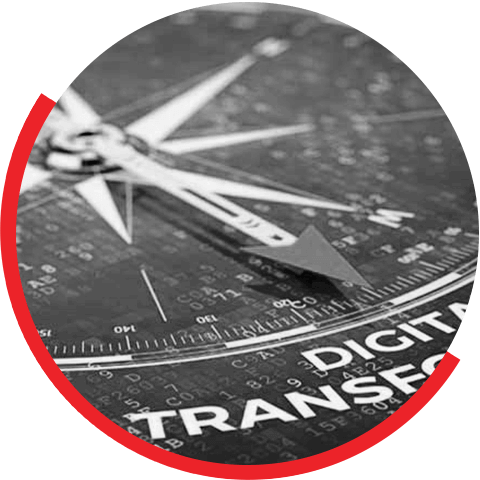The pace of technology and innovation continues to accelerate exponentially and this progression will continue to rule 2019, but there is a synergy and a pattern that has slowly started to emerge as enterprise digital transformation takes the central stage. A robust digital transformation framework becomes a key to have a successful digital journey. We had covered briefly on the 7 steps to start your digital transformation roadmap on how traditional enterprises can no longer afford to wait on the sidelines as born digital players continue to threaten their economic moats. Enterprises must re-imagine themselves as platform play businesses to reap the full benefits of an accelerated digital strategy by being open, connected, scalable & intelligent.
An optimum digital transformation technology strategy might be the edge you were looking for to give your enterprise digital transformation initiatives a much needed boost this year. What is critical is to get the technology framework right, so that a long term flexible platform based business model is constructed.
So here are the 16 technology attributes that we believe will rule 2019’s CXO priorities:
- Artificial Intelligence (AI) and Machine Learning (ML)
Well no surprises there. Artificial Intelligence and Machine learning have ruled much of 2018 and they would continue to dominate much of the digital priorities for the CXOs. These technologies have not only impacted software industry but also the other verticals such as banking, healthcare, legal, manufacturing, automobile and agriculture. - Robotic Process Automation (RPA)
Over the past year, there has been intensifying interest in Robotic Process Automation. It is already delivering value, early movers in shared services and other administrative organizations are achieving significant benefits by adopting RPA approach to improve the bottom-line. - Internet of Things (IoT)
The Internet of Things (IoT), once a niche technology for startups, is now a technology on which billion-dollar enterprises are building their futures on. Gartner predicts the number of connected things in use will hit 14.2 billion in 2019, and grow to 25 billion by 2021. From managing to smart cities to transforming entire industries IoT, has become main stream and enterprises will lose out a lot if they do not have a relevant IoT strategy in place. - API based integration
Traditional companies are realizing quickly that without integration there can be no digital transformation. With the advent of machine learning, hybrid platforms and robotic process automation (RPA), integration in itself will rapidly evolve. APIs and B2B integration will converge to drive the next generation of B2B interactions to create platform business models. - Cloud Enabled
Cloud computing has become the go to platform for fueling digital transformations and modernizing IT portfolios. Multi-cloud strategies targeted at driving innovation, complemented by containers and server less computing, will lead the cloud computing trends for 2019. - Blockchain
Blockchain has been the buzzword for recent few years, while digital transformation providers and enterprises are still trying to explore the extent of the full benefits that this technology will deliver. But not to deny that Blockchain will play a very important role in enterprise security and to improve use cases for AI and IoT. - Scalability
As enterprises will become platform businesses, it needs to be capable of sudden influx of huge demands. Which means the networks & the systems are flexible enough to keep up with the demand fluxes. By complementing with the cloud first strategy, enterprises needs to become demand ready without compromising on cost savings. - Multi device/Multi Channel capability
Recent studies revealed that the proportion of people who own a smartphone, a PC and a laptop is way higher than people who own just a smartphone. Enterprises needs to be cognizant of that fact irrespective of B2B or B2C business - an Omni-channel strategy has to be in place for a fulfilling customer experience. - Multi- Tenancy
The analysts forecast the global multi-tenant data center consumption to grow at a CAGR of 11.36% during the period 2018-2021. Multi-tenancy continues to be the backbone for Cloud Computing for IaaS and PaaS. Multitenancy makes it possible for each user to have his or her own instance of a shared application which will complement the scalability strategy of the enterprise. - Micro-services architecture
Micro-services remained a popular technology choice among the CIOs in 2018. According to a research by Couch base, as many as 50% of the respondents said that they are using micro services for application development and 38.7% are planning to use it. Scalability and faster deployment were the leading factors owing to the fast adoption of the micro service architecture. - Data Analytics
Data Analytics is a lifeline for the IT industry right now. Technologies and techniques like Big data, Data science and Deep learning, which are used in analyzing vast volumes of data are expanding rapidly. For gaining deep insights of customer behavior and system performance data analytics will continue to rule the chartbusters of 2019. - Security & Compliance
Security, once merely a small part of enterprise IT is now a significant and crucial function for organizational success. With rising demand of data protection and cyber threats, Security & Compliance have become a board room agenda. Enterprises on their digital transformation journey must keep this as one of the key priorities for 2019. - Intelligent customer experience
In a research done by Hotjar in 2018, only 12% of the respondents regarded their companies as being mature when it came to customer experience. Customer experience will dictate who will win the digital battle. A new breed of CX leaders will emerge that will use AI and Bots to their advantages while delivering superior customer experience. - Self-Learning (Platform machine learning)
Intelligent customer experience engine will be run by self- learning at the core as the user experiences will be enhanced by personalized choices and interactions. Today, self-learning is increasingly being deployed in credit card fraud detection, personalized advertising though pattern identification, personalized shopping/entertainment recommendations, to determine cab arrival times, pick-up locations and finding routes on maps etc. Over the period of time, this implicit decision making ability will drive business revenues. - Telemetry & Self-Healing
One of the major ways that DevOps can take to the next level is through self-healing. It enables systems or environments to detect and resolve problems automatically, eliminating the need for manual intervention. The DevOps teams ill take advantage of this to help achieve continuous delivery. - Data Strategy
A sound data strategy will be on the priority list for many CXOs as enterprises continues to churn out volumes and volumes of data. Whichever enterprises has good handle on their data, knows how to leverage it as a strategic differentiator. Regulatory pressures such as GDPR have done their part to increase Data Strategy awareness, but more and more companies realize that data can be a strategic business driver and managing it effectively is a good business simply.
An immediate priority for the CXO decision makers now would be to strategize and prioritize which of these 16 technology attributes make more sense for their enterprise’s digital transformation roadmap. But first and foremost, the enterprise needs to assess of where they are in their current digital journey. A simple assessment report on digital readiness like Sonata’s Digital Maturity Assessment can help identify the gaps and complement the existing digital programs to create a robust digital framework.
Hope this article helps you find the right digital strides for 2019



